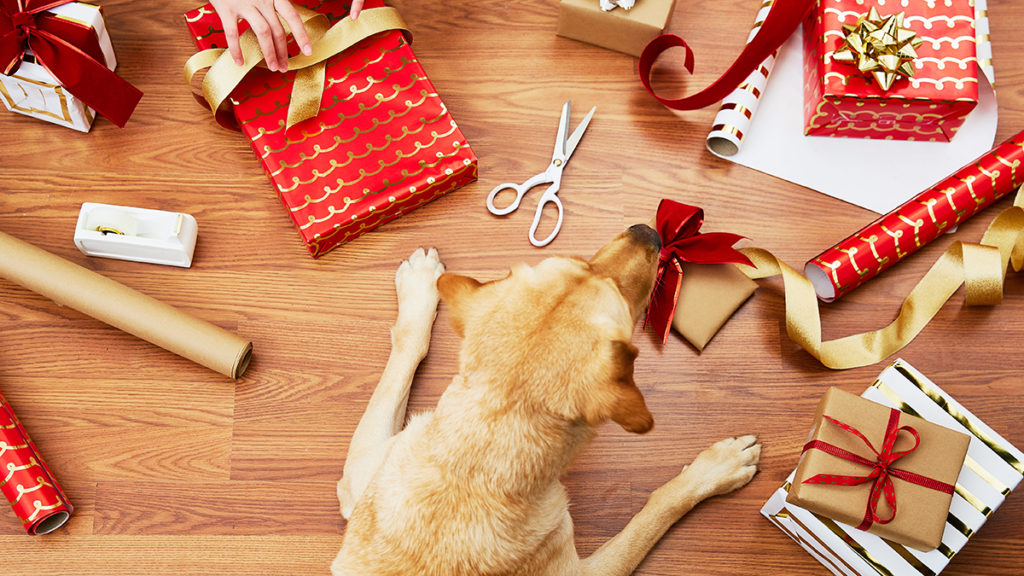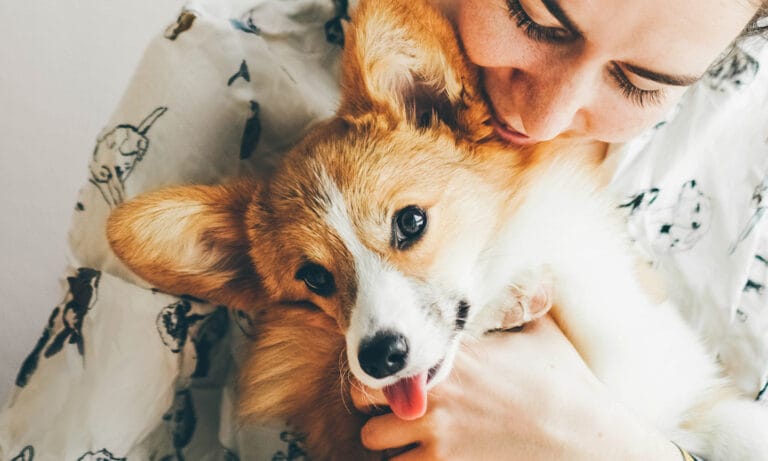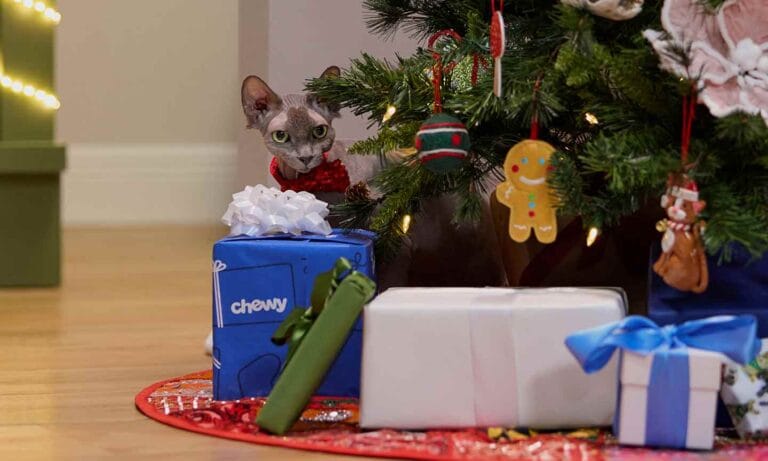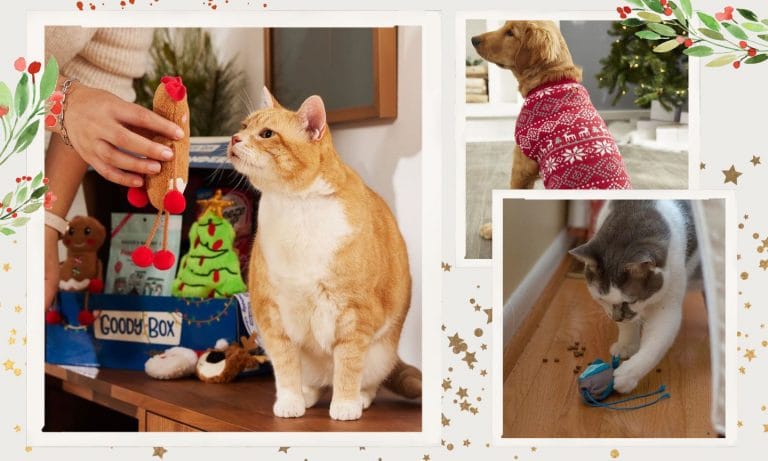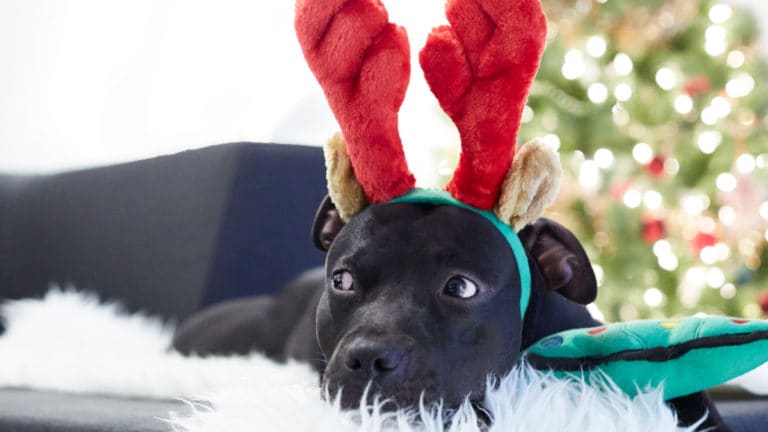It’s that time of year again—when you pull out all the holiday decorations from their storage spot and decide which ones you’ll put up around the house. As you consider items for your indoor winter wonderland theme, you should keep pet safety in mind, and determine if they pose specific pet hazards. Live plants and Christmas trees come with their own pet safety challenges, but what about all of the other knick-knacks and decorations? Here are some of the most common pet hazards that pop up around the holidays, along with a few helpful pet safety tips from the experts.
Common Holiday Pet Hazards
-
Garlands Made From Fresh Greens
Whether they’re wrapped around the tree, banister or door frame, nothing marks the beginning of the season like garlands. If you like to make garlands out of real greens, be cautious of the holiday plants you pick. “Holly and mistletoe can lead to stomach upset, excessive drooling, and abdominal pain—and large quantities of mistletoe can cause a drop in blood pressure, problems breathing, hallucinations or even seizures,” says Lindsey Pasieka, an investigator for ConsumerSafety.org and volunteer for the Danbury Animal Welfare Society in Bethel, CT. As for pine tree clippings, the needles don’t seem sharp, but they can cause stomach upset or even puncture the bowels. “The sap from pine trees can cause nausea and vomiting, as well as skin irritation,” especially for cats who will lick it off their fur as they groom themselves, notes Pasieka.
-
Tinsel Garlands and Loose Strands of Tinsel
It’s glittery, it sparkles and it adds a lot of flair to any tree or holiday scene, but tinsel, unfortunately, presents some dangerous pet hazards. Tinsel was originally made from various metals, but is now made of plastic. Although garlands can be toxic, “The larger concern with any string-like object is that cats like to play with string, and when swallowed, this can cause intestinal obstruction that requires surgery,” says Dr. Stephanie Liff, DVM at Pure Paws Veterinary Care in Brooklyn, NY. According to Dr. Austin Neely, DVM at CityVet–Mid-Cities in Flower Mound, TX, “These objects can get stuck under the tongue, in the stomach or at the beginning of the large intestine, and can be fatal if not diagnosed and removed in time. What makes them particularly dangerous is they can be extremely difficult to diagnose on X-rays and are often expensive to remove surgically.” Opt for pet-safe tree decorations, or you can use the PetSafe Pawz Away Indoor Pet Barrier, or create a barrier around the tree with the PetSafe ScatMat Electronic Pet Training Mat or IRIS 8 Panels Exercise Plastic Pen.
-
Faux Snow and Angel Hair
Artificial snow can really capture the feeling of winter, especially if you live in the hotter states. The problem is that pets like to eat these types of decorations. Cats especially love nibbling on angel hair, a vintage adornment that’s made from spun glass. If your pet ends up swallowing these decorations, they can block the intestines, leading to vomiting or even an emergency vet visit. “Vets call this a ‘linear foreign body’ because that’s how your cat’s intestines appear on x-rays after ingesting garland, tinsel and/or angel hair,” explains Integrative Veterinarian Dr. Carol Osborne, DVM, of the Chagrin Fall Veterinary Clinic in Chagrin Falls, OH.
-
Glass or Plastic Ornaments
Your pets will probably try to eat the ornaments on your tree, because they seem like toys just hanging around and waiting to be played with. But instead of being harmless toys, ornaments present some serious pet hazards. “Ornaments are concerning for obstruction more than choking and toxin. I once did an endoscopy on a pet who ate an ornament, and we found numerous other small children’s toys (G.I. Joes) all sitting in his stomach,” recalls Dr. Liff. That is definitely a scary thing for pet owners to find out, and for the pet to go through. Dr. Sarah Nold, DVM at Trupanion, advises that you should hang small and fragile ornaments high up on the tree to keep them away from wagging tails and swiping paws, but she also points out that for cats, there really is no safe height.
-
Candles and Menorahs
There’s no such thing as being too cautious when it comes to pet safety around open flames. “Candles and menorahs are fragrant and enticing to pets. They are a fire hazard, and the fumes are toxic to birds. Wagging tails easily knock over candles that may burn your pet, or worse yet, start a fire. Place them up high, out of paw reach,” says Dr. Osborne. This is pretty much the standard policy for candles in general—never leave them unattended, and keep them where children and pets can’t get to them.
-
Christmas Lights, Electrical Cords and Batteries
Before you even start to put up your Christmas lights, make sure they’re UL-approved, states Dr. Osborne. Puppies, curious cats and dogs that love to chew will more than likely find electrical and extension cords enticing. Dr. Osborne suggests hiding cords in empty wrapping paper tubes or taping the cords to the floor. You can also buy pet-proof extension cords, which you can spray with a deterrent like Grannick’s Bitter Apple Spray. “Be sure to turn them off when you’re not home and at night while you’re asleep,” adds Dr. Osborne. Batteries can be very dangerous pet hazards that should be kept away from your four-legged family members. They “contain corrosives that can ulcerate your pet’s mouth, tongue and intestines if bitten, chewed on or swallowed.”
-
Liquid Potpourri in Oil Burners and Reed Diffusers
Filling your home with the aroma of apple cider, vanilla bean or cinnamon makes it feel warm and inviting for holiday guests. Liquid potpourri is often placed in diffusers or oil burners to spread these nose-pleasing scents. But as Dr. Osborne warns, it can be dangerous, especially for cats. They’re easily knocked over by paws or a brush of the tail, and the potpourri can get onto your pet’s coat. “Then when your cat grooms himself to remove the potpourri, it can lead to ulceration and damage to your cat’s mouth, skin and eyes,” says Dr. Osborne. If this occurs, she recommends giving your cat a bath with gentle, pet-safe soap, wrapping them in a clean, warm towel, offering some warm milk and calling your vet right away.
-
Snow Globes
With their calming wintery scenes, snow globes don’t seem like obvious pet hazards, but Dr. Nold points out that they can contain ethylene glycol (antifreeze). “If the globe gets broken and your pet licks the liquid that seeps out, it only takes a small amount to be fatal. If this happens, immediately take your pet to the closest emergency veterinarian,” says Dr. Nold. Keep these miniature domed souvenirs where your pets won’t be able to get to them.
-
Wrapping Paper and Gift Decorations
When you’re getting out the gift-wrapping supplies, take everything to a table instead of working on the floor, and be careful not to drop things like string or ribbons. “Even wrapping paper and strings can quickly turn from a pup’s plaything to a choking hazard,” warns Pasieka. Pets are intrigued by the crinkly noises of the wrapping paper, and they love chewing on twine and ribbon. The only way to make sure your pets don’t ingest these materials is by keeping them well out of reach and by not leaving your gift-wrapping area unsupervised.
No pet parent wants their furry friend to end up at the emergency vet during the holidays or face a costly surgery. Take a step back, and try to see things from your pet’s point of view, noting all the things they could get into. Keep these tips in mind this holiday season, and be sure to take extra pet safety precautions as you decorate your home for the upcoming festivities.
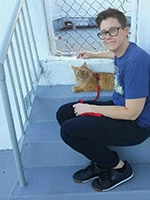
Nikki Naser, BeChewy Senior Editor
Instead of owning 30 cats, Nikki has an impressive collection of 30 cat-themed T-shirts, and just 4 pets—a ginger-haired senior cat, a senior Maine Coon, a middle-aged Choodle, and a young kitty who showed up one day on the back steps. A former Orlando resident, Nikki worked on several tourism publications before moving to South Beach. When she’s not stopping to take pics of community cats to post on Instagram, Nikki spends her time with the office pets at Chewy, writing for their BeChewy blog.
Share:
